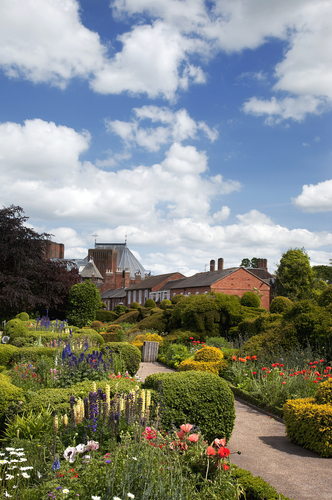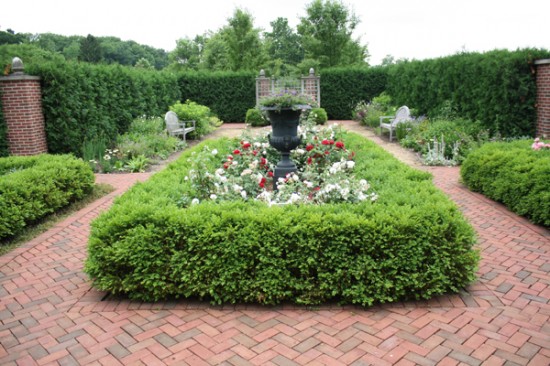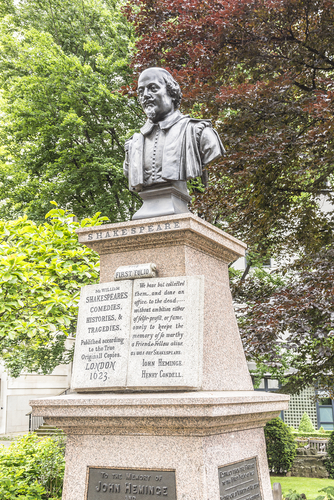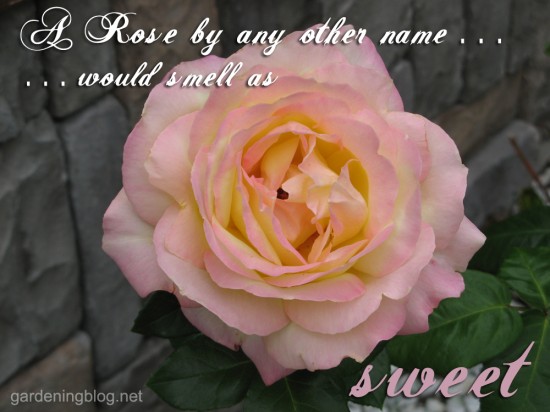Growing William Shakespeare’s Garden
October 16th, 2014So there was a guy, you may have heard of him, William Shakespeare, he was sort of a big deal. He was of course an English writer and his works have been popular for almost 500 years, that is some staying power. I actually like his stuff, I’ve read Shakespeare for pleasure, I’m that sort of nerd. Some people though, they take their devotion to the Bard to the next level.
For instance, the annoying invasive English starling was introduced to North America by some fools who wanted to bring every bird mentioned in Shakespeare’s works to our newer continent. So, in 1890 some hundred starlings were released in New York’s Central Park, now there are some 200 million of them from sea to shining sea. These same people are also responsible for the house sparrows that are everywhere now.
I do not recommend an homage to Shakespeare in the form of fauna, but flora is certainly fine. It is actually a thing to create a Shakespeare Garden.
English Gardens
There are two quintessential English gardening styles. There is the formal English garden, and the English cottage garden, either I think would be appropriate for a Shakespeare garden, though I personally feel the formal style is more suited.

Cottage Style Garden by Royal Shakespeare Theatre
An English cottage garden grew out of functional needs of small landowners in rural England, land was always strictly apportioned and commoners did not have much, so they had to make due with what they had. So the look of the cottage garden is one of very dense almost haphazard planting, a wide variety of plants but not many plantings of any single one plant. These gardens were planted for function so mostly would contain herbs and edibles and flowers mixed in to bring in pollinators or to aid in honey production. But it is all mixed together. At my current house my garden style is largely that of a cottage garden, and I’ve blogged before about things like edible ornamentals, those are all very at home in a cottage garden. Cottage gardens are also often enclosed by stone, bricks, sometimes a low fence, and they tend to make use of arbors and trellises.
A formal English garden is practically the opposite, this is for when acreage is no problem. These gardens are known for their orderly symmetrical hedgerows, precisely pruned topiaries, and geometric designs. Often they are divided into rooms or sections and contain small ponds, statuary, and other things. You can technically make a small formal garden, you can even have both formal and informal gardens on your property (I intend to do that at my next house) but it isn’t the sort of garden you can tuck into a corner between the porch and the house, nor does it lend itself stylistically to most houses.

Formal Garden Style
Another way to think of them is that cottage gardens often have curves. Curving pathways, curving borders, not much order, not even numbers of plants, no rows of anything. Formal gardens have more straight lines, straight paths, square borders and beds. The exception is perfect circles, you will still find them sometimes within a formal garden, and you could have curved topiaries or hedges in a celtic style design or something in a formal garden, but still usually in a square or rectangular bed.
Shakespeare Gardens
You could turn either of these styles of gardens into a Shakespeare garden. So what would make them a Shakespeare garden? The simplest way is to plant plants that have been mentioned in Shakespeare’s works. The next step if you wanted to put a little more work in would be that, instead of simple plant labels, you could include quotes from the plays mentioning the plant as a label. For instance, by a rose, you could have a little wooden sign saying “A rose by any other name would smell as sweet.”

Bust of William Shakespeare
Moving up the next step would be including statuary, using a bust of William Shakespeare himself. Then also bronzes or bronze plaques with the quotes rather than wood, although those all are more typical in a formal style of garden.
A Rose By Any Other Name

– William Shakespeare, Romeo & Juliet
Why are roses popular? Really, why are roses popular? Have you ever thought why some things are popular and some things are not? Roses are sweet smelling, but so are lilacs and lilies. Roses have thorns, they have numerous pest and disease problems, why are they so popular, especially among the English speaking people? Could it be because of Shakespeare? In earlier medieval times lilies were as popular than roses (and if I’m being honest, I prefer them today, not so many pest and disease problems, also no dangerous thorns), but then roses took over? Could it be the Shakespeare effect? Roses are mentioned more often than any other flower in his works, and here we have a literary collection that has been consistently popular for nearly half a millennium. Going back hundreds of years ornamental gardening was strictly a pursuit for the literate classes, so it is certainly possible that some of the most popular literature of the era could have influence on gardening. Much in the way we have little babies named Khaleesi wandering around, media influences our behavior and tastes. I don’t see why we couldn’t lay the responsibility for the popularity of roses at William Shakespeare’s feet.
Visiting a Shakespeare Garden
As I said above, Shakespeare Gardens are definitely a thing, I’m not making this up. You can even visit one, or many. You may have visited one before, this little place you may have heard of, Central Park in New York City, has a Shakespeare Garden. There are in fact at least two in the greater NYC area, two in Connecticut, a nice one in Cleveland, a couple in Illinois, one at Golden Gate Park in San Francisco, of course the most famous one in Shakespeare’s hometown of Stratford-on-Avon, and even one in my future home of Chattanooga (well, maybe there will be two there one day, hint hint), and lots more all over. If you were thinking about combining your literary and botanical pleasures, you could visit one of these sites, or visit just for fun without taking notes.
Potential Planting Possibilities
The list of plants mentioned by Shakespeare is long, you probably already grow many of these, if you wanted to pursue this form of garden design, here it is:
aconitum (monkshood), almond, aloe, apple, (also crab, pippin), apricot, ash, aspen, bachelor’s button, balm, balsam and balsamum, barley, bay, bean, bilberry, birch, blackberries and brambles, box, brier, broom, bulrush, burdock, burnet, cabbage, camomile, carnation, carraway, carrot, cedar, cherry, chestnut, clove, clover (or honey-stalks), cockle, coloquintida, columbine, cork, corn, cowslip, crow-flower, crown imperial, cuckoo-flower (buttercup), currant, cypress, daffodil, daisy, darnel, date, dewberry, dock, dogberry, ebony, eglantine, elder, elm, fennel, fern, fig, filbert, flag, flax, flower-de-luce (iris), fumitor, furze, garlic, gillyvor (carnation), ginger, gooseberry, goss or gorse, gourd, grace (rue), grape, grass, harebell, harlock (burdock), hawthorn, hazel, heath (ling), hebanon (possibly yew), hemlock, hemp, herb of grace (rue), holly, holy thistle, honeysuckle, hyssop, insane root (mythological), ivy, kecksies (hemlock), knot-grass, lady-smock, lark’s heels (larkspurs), laurel, lavender, leek, lemon, lettuce, lily, lime, ling, locust, long purple (probably orchis morio, o. mascula), love-in-idleness (pansy), mace, mallows, mandragora, mandrake (mythological), marigold (calendula or pot marigold), marjoram, marybud (marigold), mast, medlar, mint, mistletoe, moss, mulberry, mushroom, musk rose, mustard, myrtle, narcissus, nettle, nutmeg, oak, oats, olive, onion, orange, osier (willow), oxlip, palm tree, pansy, parsley, pea, peach, pear, peony, pepper, pig-nuts, pine, pink, plane tree, plantain, plum, pomegranate, poppy, potato, primrose, pumpion (probably gourd), quince, radish, reed, rhubarb, rice, rose, rosemary, rue, rush, rye, saffron (C. sativus), samphire, savory, sedge, senna, speargrass, stover (grass), strawberry, sugar, sycamore, thistle, thorn, thyme, toadstool, turnip, vetch, vine, violet, walnut, wheat, willow, woodbine (honeysuckle), wormwood, yew.
Source: The Plant-Lore and Garden-Craft of Shakespeare, by Henry N. Ellacombe. W. Satchell and Company, London, 1884.
Big list huh? Shakespeare was really into plants. If you wanted to find the exact quote for the plants this site has a william shakespeare works search that’ll fulfill your needs.

November 12th, 2014 at 11:32 am
Chris,
I loved the link between two arts here: gardening and literature. I do agree that Shakespeare could have had a huge influence on the popularity of roses during his time. Such an interesting connection. As an, English major, I also love the idea of incorporating classic quotes throughout the garden. A very special touch! Wonderful post and great job with your research!
November 13th, 2014 at 10:59 am
I love your post here about having a Shakespeare Garden. I have to say that I find English cottage gardens so lovely and romantic- and I love visiting beautiful English formal gardens nearby (just glad I don’t have to maintain one!). There aren’t many shrubs well suited for my area that take shearing neatly that well, so it’s always amazing to see what real patience and diligence can create in gardens where the effort to make the “look” happen is in abundance.
Roses are another one of those hits-and-misses in my climate- right now I have native roses that grace my property in random swaths that were probably planted by deer or birds at one point. I would love some purposeful roses around at some point though!
I especially enjoyed going through your suggested plant list and reading some of the common names you have for many of the plants. Brought back memories of reading Shakespeare’s work in high school English class.
Thank you for this fun and educational post!
-Anna
November 18th, 2014 at 2:05 pm
I am an avid reader (studied literature in undergrad), and I never noticed how many plants Shakespeare mentioned! Now I really want to have my very own Shakespeare garden. And I love your idea for the rose bush sign–might have to use that someday.
Wonderful and informative post–thanks! 🙂